数据结构实验:线性表的顺序表示和链式表示及插入、删除、查找运算
Posted
tags:
篇首语:本文由小常识网(cha138.com)小编为大家整理,主要介绍了数据结构实验:线性表的顺序表示和链式表示及插入、删除、查找运算相关的知识,希望对你有一定的参考价值。
用C语言完成以下实验:
实验内容及要求:
(1)分别建立包含10个数据元素的顺序线性表和链式线性表;
(2)从键盘输入一个数据元素,插入到线性表中第k(包含0号位置)个位置;
(3)从键盘输入一个数据元素关键字或位置k(包含1号位置),从线性表中删除相应数据元素;
(4)能完成查找功能;
(5)给出程序及插入、删除前和插入、删除后线性表结果。
我不会做。。。,希望有高手能帮帮忙,要C语言的啊,谢谢了
#include <stdio.h>
#include <stdlib.h>
#include<conio.h>
struct list //结点类型
int data;
struct list *next;
;
struct list *head;//声明结点指针
int static length;//声明表长变量
struct list *creat_n()//创建有n个元素的链表
struct list *q,*p,*head=NULL;
printf("\n输入你所要创建的结点数: ");
scanf("%d",&length);
head=p=(list*)malloc(sizeof(list)); //创建一个新结点并用头指针指向它
printf("输入该结点的值: ");
scanf("%d", &p->data);
p->next=NULL;
for(int i=length-1;i>=1;i--)
q=p;
p=(list*)malloc(sizeof(list)); //创建新结点
printf("输入该结点的值: ");
scanf("%d", &p->data);
q->next=p;
printf("输入完毕\n\n");
p->next=NULL;
return head;
struct list * output()//输出表长与结点值函数
struct list *p;
p=head;
printf("\n当前链表中存有的元素:\n");
while(p!=NULL)
printf("%d\n",p->data);
p=p->next;
printf("当前的表长是: %d\n\n",length);//输出当前表长
return head;
void insert()//插入结点函数
struct list *k,*p,*q;
int x;
printf("请输入你要在哪个结点值之前插入新结点: ");
scanf("%d",&x);
k=(list*)malloc(sizeof(list));//创建新结点
printf("请输入新结点的值: ");
scanf("%d",&k->data);
k->next=NULL;
if(head==NULL)//若链表为空,则直接入链表
head=k;
length=length+1;
printf("插入成功\n\n");
else if(head->data==x)//在第一个结点前插入新结点
k->next=head;
head=k;
printf("插入成功\n\n");
length=length+1;
else
q=head;
p=head->next;
while((p != NULL) && (p->data != x))//找出值为X的结点的位置
q = p;
p = p->next;
if (p == NULL)
q->next=k;//在链表末插入新结点
printf("插入成功\n");
length=length+1;
else if(p->data == x)//在要求的X结点前插入新结点
k->next=p;
q->next=k;
printf("插入成功\n\n");
length=length+1;
output();
int delet()//删除结点函数
struct list *q,*p;
int x,y;
printf("请输入你所要删除的结点值: ");
scanf("%d",&x);
if(head==NULL)//表空
printf("表空\n");
return 0 ;
else if(x==head->data)//第一个结点为删除的结点
q=head;
head=head->next;
y=q->data;
free(q);
printf("删除成功\n\n");
length=length-1;
output();
return(y);
else
q=head;
p=head->next;
while((p != NULL) && (p->data != x))//找出值为X的结点
q=p;
p=p->next;
if(p==NULL)
printf("没有删除对象\n");
if(x==p->data)//删除值为X的结点
q->next=p->next;
y=p->data;
free(p);
printf("删除成功\n\n");
length=length-1;
output();
return (y);
else
printf("表中没有指定的结点\n");
output();
return 0;
return 0;
void find()
struct list *p;
int k,x,i=1;
char y,n;
LOOP:
p=head;
printf("请输入你要查找的结点值: ");
scanf("%d",&x);
while(p->data!=x)
p=p->next;
i++;
printf("你所查找的结点是表中第 %d 个结点!\n\n",i);
printf("是否要继续查找,请输入y/n\n\n");
k=getch();
if(k=='y')
i=1;
goto LOOP;
else
return;
void main()
printf("计Y062 200502001052 李抱和\n\n");
int a;
LOOP:
printf(" *****************\n");
printf(" ** 1 创建链表 **\n");
printf(" ** 2 链表输出 **\n");
printf(" ** 3 插入结点 **\n");
printf(" ** 4 删除结点 **\n");
printf(" ** 5 查找结点 **\n");
printf(" *****************\n");
printf("\n请选择: ");
scanf("%d",&a);
switch(a)
case 1 :
head=creat_n();
break;
case 2 :
output();
break;
case 3 :
insert();
break;
case 4 :
delet();
break;
case 5 :
find();
break;
goto LOOP;
参考技术A #include<stdio.h>#include<stdlib.h>
typedef int ElemType;
/*构建结点结构体 */typedef struct LNode
int data;
struct LNode * next;
LNode, * LinkList;
/*用于创建链表的函数 */
/*反序构建的*/
LinkList CreateList_L(LinkList L, int n)
int i;
LinkList p;
L = (LinkList)malloc(sizeof(LNode));
L->next = NULL;
for(i = 0; i < n; ++i)
p = (LinkList)malloc(sizeof(LNode));
scanf("%d",&p->data);
p->next = L->next;
L->next = p;
return L;
/*用于查找的函数*/LinkList GetElem_L(LinkList L,int i,ElemType &e)
LinkList p = L;
int j;
p = L->next;j = 1;
while(p && j<i)
p = p->next;
++j;
if(!p || j>i)
printf("表中无此位置。\n");
return L;
e = p->data;
printf("%d\n",e);
return L;
/* 用于插入结点的函数 */LinkList ListInsert_L(LinkList L, int i, int newnode)
LinkList p = L;
LinkList s;
int j = 0;
while(p&&j<i-1)
p = p->next;
++j;
if(!p||j>i-1)
printf("位置小于1或大于表长。\n");
return L;
s = (LinkList)malloc(sizeof(LNode));
s->data = newnode;
s->next = p->next;
p->next = s;
return L;
/* 用于删除结点的函数 */LinkList ListDelete_L(LinkList L, int i)
LinkList p = L;
LinkList s;
int j=0;
while(p->next&&j<i-1)
p = p->next;
++j;
if(!(p->next)||j>i-1)
printf("删除位置不合理。\n");
return L;
s = p->next;
p->next = s->next;
printf("%s%d\n","被删除的结点是:",s->data);
free(s);
return L;
/*用于遍历链表的函数 */
void ListDisp_L(LinkList L)
LinkList p;
int i=0;
p = L->next;
while(p)
printf("%d:%d\n", ++i,p->data);
p = p->next;
int main()
int where;
int value;
int count;
int search;
int output;
LinkList L; printf("请输入链表初始结点数:");
scanf("%d",&count);
printf("请输入各个结点数值,每输入一个按回车确认:\n");
L = CreateList_L(L, count);
printf("请输入要查找的位置:");
scanf("%d",&search);
L = GetElem_L(L,search,output);
printf("请输入插入的位置:");
scanf("%d", &where);
printf("请输入要插入的数值:");
scanf("%d", &value);
L = ListInsert_L(L,where,value);
ListDisp_L(L);
printf("请输入要删除的位置:"); scanf("%d",&where);
L = ListDelete_L(L,where);
ListDisp_L(L);
return 0;
参考技术B 一.实验目的
熟悉线性表的表示及实现方法。掌握线性表的基本操作:插入、删除、查找等运算在链式存储结构上的运算。
二.实验内容
1.问题描述
设计一个单链表基本操作的程序
2.基本要求
编写一个程序实现单链表的各种基本运算,包括:
(1)初始化单链表;
(2)依次插入n个元素(自行编写),建立带头结点的单链表;
(3)输出单链表;
(4)计算单链表的长度;
(5)判断单链表是否为空;
(6)输出单链表的第i个元素;
(7)在第i个元素位置上插入一个数据元素;
(8)删除单链表的第i个元素。
三.实验环境
Microsoft Visual C++ 6.0
四.测试数据
自行编写测试数据进行测试 参考技术C struct node
char data;
struct node *next;
;
typedef struct node NODE;
/*This function creates a link_list with N nodes.*/
NODE *create_link_list(int n)
int i;
NODE *head, *p, *q;
if (n==0) return NULL;
head = (NODE *) malloc(sizeof(NODE));
p = head;
printf("Please input %d chars for the link list\n",n);
for (i=0; i<n; i++)
scanf("%c ", &(p->data));
q=(NODE *)malloc(sizeof(NODE));
printf("test3\n");
p->next=q;
p=q;
scanf("%c ",&(p->data));
getchar();
p->next=NULL;
return (head);
/*This function inserts a node whose value is b*/
/*before the node whose value is a, if the node is not exist,*/
/*then insert it at the end of the list*/
void insert(NODE **p_head, char a, char b)
NODE *p, *q;
q = (NODE *)malloc(sizeof(NODE));
q->data = b;
q->next =NULL;
if (* p_head == NULL) * p_head = q;
else
p=(NODE*)malloc(sizeof(NODE));
p = * p_head;
while (p->data != a && p->next != NULL)
p = p->next;
q->next = p->next;
p->next = q;
/*The function deletes the node whose value is a,*/
/*if success, return 0, or return 1*/
int deletenode(NODE **p_head, char a)
NODE *p, *q;
q=*p_head;
if (q==NULL) return(1);
if (q->data == a)
* p_head = q->next;
free(q);
return (0);
else
while (q->data != a && q->next != NULL)
p = q;
q = q->next;
if (q->data == a)
p->next = q->next;
free(q);
return(0);
else return(1);
void main()
NODE *my_head,*p;
/* create a link list with m nodes */
int m;
char ch_a,ch_b;
printf("please input the number of nodes for the link_list\nm=");
scanf("%d",&m);
getchar();
printf("test1\n");
my_head = (NODE *) malloc(sizeof(NODE));
my_head=create_link_list(m);
/*Output the link list*/
printf("The link list is like:\n");
p=my_head;
while (p != NULL)
printf("%c ",p->data);
p=p->next;
printf("\n");
/*insert a node whose value is b before a*/
printf("Please input the position for a\n ch_a=");
getchar();
scanf("%c",&ch_a);
getchar();
printf("Please input the value that you want to insert\n ch_b=");
scanf("%c",&ch_b);
getchar();
insert(&my_head,ch_a,ch_b);
printf("The link list after insertion is like:\n");
p=my_head;
while (p != NULL)
printf("%c ",p->data);
p=p->next;
printf("\n");
/*delete a node whose value is a*/
printf("Please input the position for a a=");
scanf("%c",&ch_a);
getchar();
deletenode(&my_head,ch_a);
printf("The link list after deleting is like:\n");
p=my_head;
while (p != NULL)
printf("%c ",p->data);
p=p->next;
printf("\n");
数据结构开发:线性表的链式存储结构
0.目录
1.线性表的链式存储结构
2.单链表的具体实现
3.顺序表和单链表的对比分析
4.小结
1.线性表的链式存储结构
顺序存储结构线性表的最大问题是:
- 插入和删除需要移动大量的元素!如何解决?
链式存储的定义:
- 为了表示每个数据元素与其直接后继元素之间的逻辑关系;数据元素除了存储本身的信息外,还需要存储其直接后继的信息。

链式存储逻辑结构:
- 基于链式存储结构的线性表中,每个结点都包含数据域和指针域
- 数据域:存储数据元素本身
- 指针域:存储相邻结点的地址

专业术语的统一:
- 顺序表
- 基于顺序存储结构的线性表
- 链表
- 基于链式存储机构的线性表
- 单链表:每个结点只包含直接后继的地址信息
- 循环链表:单链表中的最后一个结点的直接后继为第一个结点
- 双向链表:单链表中的结点包含直接前驱和后继的地址信息
- 基于链式存储机构的线性表
链表中的基本概念:
- 头结点
- 链表中的辅助结点,包含指向第一个数据元素的指针
- 数据结点
- 链表中代表数据元素的结点,表现形式为:( 数据元素,地址 )
- 尾结点
- 链表中的最后一个数据结点,包含的地址信息为空
单链表中的结点定义:

单链表中的内部结构:

头结点在单链表中的意义是:辅助数据元素的定位,方便插入和删除操作;因此,头结点不存储实际的数据元素。
在目标位置处插入数据元素:
- 从头结点开始,通过current指针定位到目标位置
- 从堆空间申请新的Node结点
- 执行操作:
node->value = e;node->next = current->next;current->next = node;
在目标位置处删除数据元素:
- 从头结点开始,通过current指针定位到目标位置
- 使用toDel指针指向需要删除的结点
- 执行操作:
toDel = current->next;current->next = toDel->next;delete toDel;
2.单链表的具体实现
本节目标:
- 完成链式存储结构线性表的实现
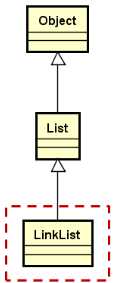
LinkList 设计要点:
- 类模板,通过头结点访问后继结点
- 定义内部结点类型Node,用于描述数据域和指针域
- 实现线性表的关键操作( 增,删,查,等 )
LinkList的定义:
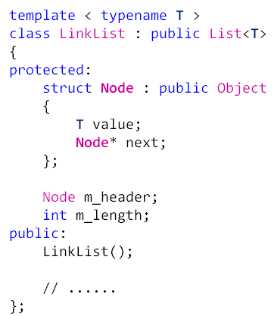
链表的实现 LinkList.h:
#ifndef LINKLIST_H
#define LINKLIST_H
#include "List.h"
#include "Exception.h"
namespace StLib
{
template <typename T>
class LinkList : public List<T>
{
protected:
struct Node : public Object
{
T value;
Node* next;
};
mutable Node m_header;
int m_length;
public:
LinkList()
{
m_header.next = NULL;
m_length = 0;
}
bool insert(const T& e)
{
return insert(m_length, e);
}
bool insert(int i, const T& e)
{
bool ret = ((0 <= i) && (i <= m_length));
if( ret )
{
Node* node = new Node();
if( node != NULL )
{
Node* current = &m_header;
for(int p=0; p<i; p++)
{
current = current->next;
}
node->value = e;
node->next = current->next;
current->next = node;
m_length++;
}
else
{
THROW_EXCEPTION(NoEnoughMemoryException, "No memory to insert new element ...");
}
}
return ret;
}
bool remove(int i)
{
bool ret = ((0 <= i) && (i < m_length));
if( ret )
{
Node* current = &m_header;
for(int p=0; p<i; p++)
{
current = current->next;
}
Node* toDel = current->next;
current->next = toDel->next;
delete toDel;
m_length--;
}
return ret;
}
bool set(int i, const T& e)
{
bool ret = ((0 <= i) && (i < m_length));
if( ret )
{
Node* current = &m_header;
for(int p=0; p<i; p++)
{
current = current->next;
}
current->next->value = e;
}
return ret;
}
T get(int i) const
{
T ret;
if( get(i, ret) )
{
return ret;
}
else
{
THROW_EXCEPTION(IndexOutOfBoundsException, "Invalid parameter i to get element ...");
}
return ret;
}
bool get(int i, T& e) const
{
bool ret = ((0 <= i) && (i < m_length));
if( ret )
{
Node* current = &m_header;
for(int p=0; p<i; p++)
{
current = current->next;
}
e = current->next->value;
}
return ret;
}
int length() const
{
return m_length;
}
void clear()
{
while ( m_header.next )
{
Node* toDel = m_header.next;
m_header.next = toDel->next;
delete toDel;
}
m_length = 0;
}
~LinkList()
{
clear();
}
};
}
#endif // LINKLIST_Hmain.cpp测试
#include <iostream>
#include "LinkList.h"
using namespace std;
using namespace StLib;
int main()
{
LinkList<int> list;
for(int i=0; i<5; i++)
{
list.insert(0, i);
list.set(0, i*i);
}
for(int i=0; i<list.length(); i++)
{
cout << list.get(i) << endl;
}
cout << endl;
list.remove(2);
for(int i=0; i<list.length(); i++)
{
cout << list.get(i) << endl;
}
cout << endl;
list.clear();
for(int i=0; i<list.length(); i++)
{
cout << list.get(i) << endl;
}
return 0;
}运行结果为:
16
9
4
1
0
16
9
1
0
问题:
- 头结点是否存在隐患?
- 实现代码是否需要优化?
头结点的隐患:
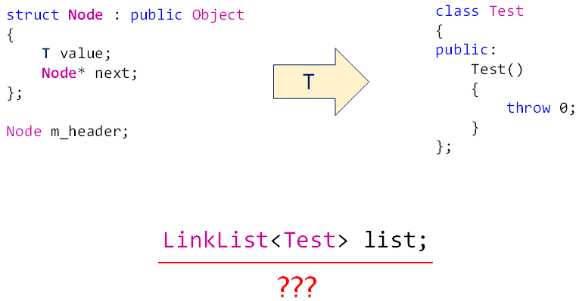
代码优化:
- insert,remove,get,set等操作都涉及元素定位。

代码优化(LinkList.h):
#ifndef LINKLIST_H
#define LINKLIST_H
#include "List.h"
#include "Exception.h"
namespace StLib
{
template <typename T>
class LinkList : public List<T>
{
protected:
struct Node : public Object
{
T value;
Node* next;
};
mutable struct : public Object
{
char reserved[sizeof(T)];
Node* next;
} m_header;
int m_length;
Node* position(int i) const
{
Node* ret = reinterpret_cast<Node*>(&m_header);
for(int p=0; p<i; p++)
{
ret = ret->next;
}
return ret;
}
public:
LinkList()
{
m_header.next = NULL;
m_length = 0;
}
bool insert(const T& e)
{
return insert(m_length, e);
}
bool insert(int i, const T& e)
{
bool ret = ((0 <= i) && (i <= m_length));
if( ret )
{
Node* node = new Node();
if( node != NULL )
{
Node* current = position(i);
node->value = e;
node->next = current->next;
current->next = node;
m_length++;
}
else
{
THROW_EXCEPTION(NoEnoughMemoryException, "No memory to insert new element ...");
}
}
return ret;
}
bool remove(int i)
{
bool ret = ((0 <= i) && (i < m_length));
if( ret )
{
Node* current = position(i);
Node* toDel = current->next;
current->next = toDel->next;
delete toDel;
m_length--;
}
return ret;
}
bool set(int i, const T& e)
{
bool ret = ((0 <= i) && (i < m_length));
if( ret )
{
position(i)->next->value = e;
}
return ret;
}
T get(int i) const
{
T ret;
if( get(i, ret) )
{
return ret;
}
else
{
THROW_EXCEPTION(IndexOutOfBoundsException, "Invalid parameter i to get element ...");
}
return ret;
}
bool get(int i, T& e) const
{
bool ret = ((0 <= i) && (i < m_length));
if( ret )
{
e = position(i)->next->value;
}
return ret;
}
int length() const
{
return m_length;
}
void clear()
{
while ( m_header.next )
{
Node* toDel = m_header.next;
m_header.next = toDel->next;
delete toDel;
}
m_length = 0;
}
~LinkList()
{
clear();
}
};
}
#endif // LINKLIST_H3.顺序表和单链表的对比分析
问题
- 如何判断某个数据元素是否存在于线性表中?
遗失的操作——find:
- 可以为线性表( List )增加一个查找操作
- int find(const T& e) const;
- 参数:
- 待查找的数据元素
- 返回值:
=0:数据元素在线性表中第一次出现的位置
- -1:数据元素不存在
- 参数:
数据元素查找示例:
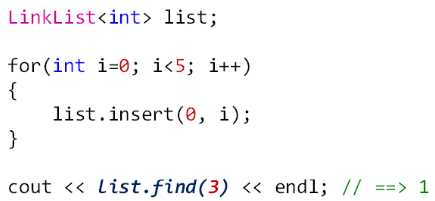
实现查找find函数:
在List.h中加入
virtual int find(const T& e) const = 0;在SeqList.h中加入
int find(const T& e) const
{
int ret = -1;
for(int i=0; i<m_length; i++)
{
if( m_array[i] == e )
{
ret = i;
break;
}
}
return ret;
}在LinkList.h中加入
int find(const T& e) const
{
int ret = -1;
int i = 0;
Node* node = m_header.next;
while ( node )
{
if( node->value == e )
{
ret = i;
break;
}
else
{
node = node->next;
i++;
}
}
return ret;
}但是若用类对象来进行测试,会有严重的bug:
#include <iostream>
#include "LinkList.h"
using namespace std;
using namespace StLib;
class Test
{
int i;
public:
Test(int v = 0)
{
i = v;
}
};
int main()
{
Test t1;
Test t2;
Test t3;
LinkList<Test> list;
return 0;
}编译错误信息:
error C2678: 二进制“==”: 没有找到接受“Test”类型的左操作数的运算符(或没有可接受的转换)于是应该在顶层父类Object中实现重载比较操作符
Object.h
bool operator == (const Object& obj);
bool operator != (const Object& obj);Object.cpp
bool Object::operator == (const Object& obj)
{
return (this == &obj);
}
bool Object::operator != (const Object& obj)
{
return (this != &obj);
}main.cpp再测试
#include <iostream>
#include "LinkList.h"
using namespace std;
using namespace StLib;
class Test : public Object
{
int i;
public:
Test(int v = 0)
{
i = v;
}
bool operator == (const Test& t)
{
return (i == t.i);
}
};
int main()
{
Test t1(1);
Test t2(2);
Test t3(3);
LinkList<Test> list;
list.insert(t1);
list.insert(t2);
list.insert(t3);
cout << list.find(t2) << endl;
return 0;
}运行结果为:
1时间复杂度对比分析:
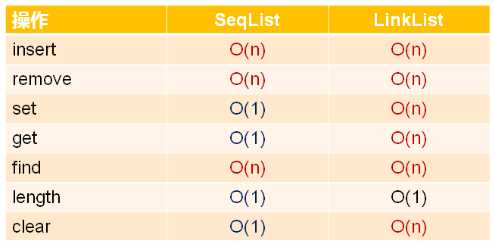
有趣的问题:
- 顺序表的整体时间复杂度比单链表要低,那么单链表还有使用价值吗?
效率的深度分析:
- 实际工程开发中,时间复杂度只是效率的一个参考指标
- 对于内置基础类型,顺序表和单链表的下效率不相上
- 对于自定义类类型,顺序表在效率上低于单链表
- 插入和删除
- 顺序表:涉及大量数据对象的复制操作
- 单链表:只涉及指针操作,效率与数据对象无关
- 数据访问
- 顺序表:随机访问,可直接定位数据对象
- 单链表:顺序访问,必须从头访问数据对象,无法直接定位
工程开发中的选择:
- 顺序表
- 数据元素的类型相对简单,不涉及深拷贝
- 数据元素相对稳定,访问操作远多于插入和删除操作
- 单链表
- 数据元素的类型相对复杂,复制操作相对耗时
- 数据元素不稳定,需要经常插入和删除,访问操作较少
4.小结
- 链表中的数据元素在物理内存中无相邻关系
- 链表中的结点都包含数据域和指针域
- 头结点用于辅助数据元素的定位,方便插入和删除操作
- 插入和删除操作需要保证链表的完整性
- 通过类模板实现链表,包含头结点成员和长度成员
- 定义结点类型,并通过堆中的结点对象构成链式存储
- 为了避免构造错误的隐患,头结点类型需要重定义
- 代码优化是编码完成后必不可少的环节
- 线性表中元素的查找依赖于相等比较操作符( == )
- 顺序表适用于访问需求量较大的场合( 随机访问 )
- 单链表适用于数据元素频繁插入删除的场合( 顺序访问 )
- 当数据类型相对简单时,顺序表和单链表的效率不相上下
以上是关于数据结构实验:线性表的顺序表示和链式表示及插入、删除、查找运算的主要内容,如果未能解决你的问题,请参考以下文章